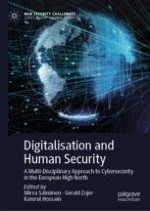2020 | OriginalPaper | Buchkapitel
2. Comprehensive Cybersecurity and Human Rights in the Digitalising European High North
verfasst von : Mirva Salminen, Gerald Zojer, Kamrul Hossain
Erschienen in: Digitalisation and Human Security
Aktivieren Sie unsere intelligente Suche, um passende Fachinhalte oder Patente zu finden.
Wählen Sie Textabschnitte aus um mit Künstlicher Intelligenz passenden Patente zu finden. powered by
Markieren Sie Textabschnitte, um KI-gestützt weitere passende Inhalte zu finden. powered by
